Back
In Russian
Contents Sumers
Contents Amerindian
Roots
Writing
Language
Religion
Geography
Archeology
Coins
Wikipedia
Türkic, Slavic and Iranian
Türkic in Romance
Alans in Pyrenees
Türkic in Greek
Türkic in Slavic
Türkic languages
Classification of Türkic languages
Indo-European, Dravidian, and Rigveda
Türkic and European Genetic distance
Türkic-Sumerian
Avar Dateline
Besenyo Dateline
Bulgar Dateline
Huns Dateline
Karluk Dateline
Kimak Dateline
Kipchak Dateline
Kyrgyz Dateline
Sabir Dateline
Seyanto Dateline
ORIGIN OF TÜRKS - SUMERIAN LANGUAGE

Mirfatyh Zakiev
Origin of Türks and Tatars
Part one
ORIGIN OF TÜRKS
Introduction
Page numbers, where shown, indicate pages in the book publication. The offered copy of the printed edition contains typos and misspellings, for which I apologize and intend to correct them with time.
The spelling of the Greek-based quasi-Cyrillic-Tatar letters, occasionally used by the author to signify a Türkic phonetics inexpressible by the mandated Cyrillics, is transcribed from the quasi-Cyrillic to English, with the following conventions:
Replaced:
quasi-Cyrillic "ú" ( ' - stop-guttural consonant ) with " ' ",
like in "súkúd" => "S'k'd"
quasi-Cyrillic "í1" ( n + guttural consonant
"g") with "ng", like in "äèí1ãåçå"
=> "Dinggeze"
Cyrillic "ë" (yo) "ë"
Other conventions:.
"a" - as "a" in arch, "j" - as "j" in jealousy, "kh" - as "h" in hug, "ü" - as
"u" in munitions, "y" - as "Y" in York or as "i" in if
Third chapter
Ancient Türkic-speaking areas
78
26. The role of Türkic language in the detection of ancient Türkic areas.
In the official (Russian - Translator's Note) Eurocentric historical science, Türks were classed as the so-called young, unhistorical peoples. The time of separation the Türks from the Altai community was considered the 6th millennium BC. Against those scientists who tried to detect more ancient ethnic roots of Türks (in Russia - Translator's Note) was conducted an official "struggle" which was called the "Struggle Against Antiquating the History of the Small Nations".
Some Türkologists, who could not agree with the official viewpoint about the age of Türks, made confident attempts to find more ancient traces of the Türks in the languages of the American Indians, who left of Eurasia 20-30 thousand years ago, and also in the Sumerian language, which was using cuneiform writing still in 4th millennium BC. In these languages was found a whole system of the Türkic designations for some concepts belonging to the different spheres of the human activities.
The supporters of the traditional Türkology, the fighters against antiquating the ethnic roots of Türks, very bravely opposed by the scientists who found Türkic words in some languages of the American Indians, and in the language of the Sumer cuneiform writings. They, coming from the features of the Indo-European languages, said that the Türkic words for the five - fifteen thousand years would have changed so much that they should not coincide with the modern Türkic words in any way, therefore ostensibly antiquators of the Türkic history would try vainly to find the Türkic words in the above languages, it would be lost efforts....
Comparing the development of the inflectional (expressing grammatical relations by changes in vowels or consonants - Translator's Note) and agglutinating (expressing grammatical relations by stringing together component morphemes that retain their form and meaning in the process of combining - Translator's Note) languages, at once is evident a huge difference between them. In the inflectional languages, and in particular in the Indo-European, a root of a word is unstable (i.e. undergoes grammatical change), it undergoes phonetical changes. For example, (Russian - Translator's Note) words khodit and khojdenie have the same root, but are phonetically different. The words chado in Russian and kind in German (Eng. child and kid - Translator's Note) also go back to the same root. This is also a result of the changes of the roots of words in the inflectional languages. Precisely this feature of the inflectional languages results that eventually the words in inflectional languages can accept a different phonetic form. Therefore in many cases the modern voicing of a word does not coincide with its ancient voicing. Hence, the modern condition of an inflectional language is of little use in the studies of the ethnical roots for the carriers of the language. To learn the ancient sounding of many words in the inflectional languages, a deep comparative-historical research of these languages has to be performed.
In the agglutinating languages the roots of words almost do not change with time, for during their application (i.e. at grammatical changes) they do not lose their initial phonetical form. In the ancient written sources can be also found the modern phonetical form of the words in the agglutinating languages (hence, also in the Türkic language). Therefore also in the languages of some American Indians, in spite of the fact that they departed the Türks of the Eurasia 20-30 thousand years ago, we find the Türkic words little different from the modern words of the Türks. The Sumerian cuneiform texts are also rich with the Türkic words similar to the modern Türkic. These facts are not perceived by the traditionalists Türkologists who only understand the specifics of the inflectional languages.
Thus, understanding the stability of the Türkic lexical units would ease the understanding of the huge value of this feature in the detecting the traces of the most ancient ethnic roots of the Türks, hence, in the location the ancient Türkic-speaking areas...
The Ü.V.Knorozov's research makes it obvious that the Maya social system reminds the conditions in Sumer and Egypt: there and here the clan society is combined with the slaveholding society [Diego de Landa, 1955, 37].
83
28. Bright traces of the Türks in the Sumerian language.
In the southern regions of the Bi-fluvial between the rivers Tiger and Euphrates in the 5th-3rd millenniums BC was located the country of Shumers/Sumers (see map). By the I.M.Diyakonov's data [BSE, 3 rev., vol. 29, 517], the country before the end of the 3rd millennium up BC was settled mostly by the Sumerians and to a lesser degree, by eastern Semites-Akkadians who managed to take control in their hands, and from the middle of the 3rd millennium BC country began to be called "Sumer and Akkad". In the beginning of the 2nd millennium BC there emerged the state Babylonia, which preserved its independence until the 6th century BC. The Babylonians had to repeatedly repulse the attacks of the Kassites, Assyrians and Elamites, who nevertheless mixed up with the local Sumerians, Akkadians, Babylonians. In that boiling pot the Sumerian language, apparently, was assimilated. But the examples of the original language remained in their cuneiform texts. The cuneiform writing of the Sumerians was then adopted and developed by the Akkadians, Elamites, Hurrites, Hetto-Luvians and Urartians.
The Sumerian system of the cuneiform writing was deciphered by a number of the scientists at the end of the 19th - the beginning of the 20th centuries. And precisely this deciphered from the cuneiform writings Sumer language turned out to be rich with the Türkic lexicon.
With the a hope to reveal their ancient ancestors the Sumerian language initially was studied by the Indo-Europeans, who searched for parallels and similarities to their languages. Among them was F.Hommel who in the Sumerian texts found 200 words coinciding with Türkic words [Hommel F. , 1915], for which he was laughed at and satirized.
A Russian scientist I.M.Diyakonov has devoted a lot of time to the study and decoding of the Sumerian texts. He could not even imagine an idea about any affinity of the Sumerian language with Türkic. Comparing the Sumerian words with the Indo-European, he does not find a single case of coincidence and comes to a conclusion, that the poor Sumerian language was isolated from the others [Diyakonov I.M., 1954, 84]. Generally, this conclusion is strange from the scientists viewpoint, for on the globe there are no and can not be isolated languages.
In the book of I.M.Diyakonov, who happened to have no clue about the affinity of the Sumerian and Türkic languages, Olyas Suleymenov observed 60 Sumerian words similar to the Türkic words: ada "father", ama "mother", tu "to give birth", ere "man", "soldier", ugu "arrow", tag "fasten", zag "side", bilga "wise, ancestor", me "I", ze "you", ane "here, now", gud "bull", gash "bird", kir "dirt, soil", ush "three", u "ten", ken "wide", uzuk "long", tush "descend", ud "fire", udun "tree, firewood", dingir "god, sky", tengir "god, sky", etc. O.Suleymenov [Suleymenov Î., 1975, 230-242] subjects each word to research, proves the Sumero-Türkic concurrences and comes to a conclusion that:
a) convergences are systematic, so they are real;
b) Sumerian and Türkic languages influenced each other for many years ;
c) These languages are not related genetically, but as a result of the cultural influences.
Turkish scientist Osman Nedim Tuna consistently studied Sumero-Türkic parallels since 1947. n the international congresses, The results of his research he presented in international congresses, he repeatedly consulted with many experts, and only after that has decided in 1990 to publish a special book, where he attempts to define the age of the Türkic language, based on the Sumero-Türkic parallels. In this book O.N.Tuna relays the comparative-historical study of the 168 Sumerian words, locating their roots in the Ancient Türkic language, he studies the phonetic and grammatical features of both languages. The scientist comes to a conclusion that so far the sufficient proofs are absent to state a genetic relationship between Sumerian and Türkic languages, the found material up untill now only proves that these languages for a long time mutually influenced each other very strongly [Tuna O.N., 1990, 49].
O.N.Tuna suggests that the Türkic language 5,500 years b.p. already had a logically developed by its carriers phonetical set and grammatical system. Allowing another 5500 years before that for the development of this system, the age of the Türkic language appears to be 11 thousand years. As to time of the recording of the Türkic language in writing (Sumerian cuneiform writing), it was 8,000-8,500 years ago [Tuna O.N., 1990, 49].
So far remain unanswered in the scientists literature the questions of where the Sumerians received that strong influence of the Türks: before their arrival in the Mesopotamia, or next to them there lived the Türkic tribes, or maybe the Sumerians once were Türks but in the 4th-3rd millenniums BC they went through a period of assimilation among the Semite-speaking Akkadians.
86
29. Ancient Türkic-speaking areal in the Near East. The Türkologists studying the Türkic loans in the Sumerian language untill now assumed that the Sumerians before the 4th millennium BC lived somewhere near the Türks, adopted Türkic words from them, and then migrated to the Mesopotamia of the Euphrates and Tiger. The question the presence of the Türkic-speaking area in the Near East was not studied by anybody, for the everywhere was held the notion about the arrival of the first Türks to the Near East and Asia Minor only in the 11th century AD.
The study of the Sumerian, Akkadian, Assyrian and Urartian sources allowed to newly illuminate the ancient history of the Near East. So, the Azerbaijanian linguist Firidun Agasyoglu Djalilov, ascertains on the basis of the study of the above named sources that in the 4th-3rd millenniums BC in the headwaters of the river Tiger between the Assyria and Urartu lived Türkic-speaking Subars (sub-ar "River People"). A little below were noted the Türkic-speaking Kumans, and further the Türkic-speaking Gutii, Lulu, and in the south of the lake Urmia also were noted the Türkic-speaking Turuks. Besides, according to the Assyrian, Akkadian and Urartian sources, among these groups was also noted the presence of other Türkic-speaking tribes under the names Kumug, Kashgay, Gügèr, Salur, etc. [Firidun Agasyoglu, 2000, 41-66, 156-162] (see two maps per Firidun Agasyoglu).
Sumer in the 3rd-2nd millenia BC
by Firidun Agasyoglu
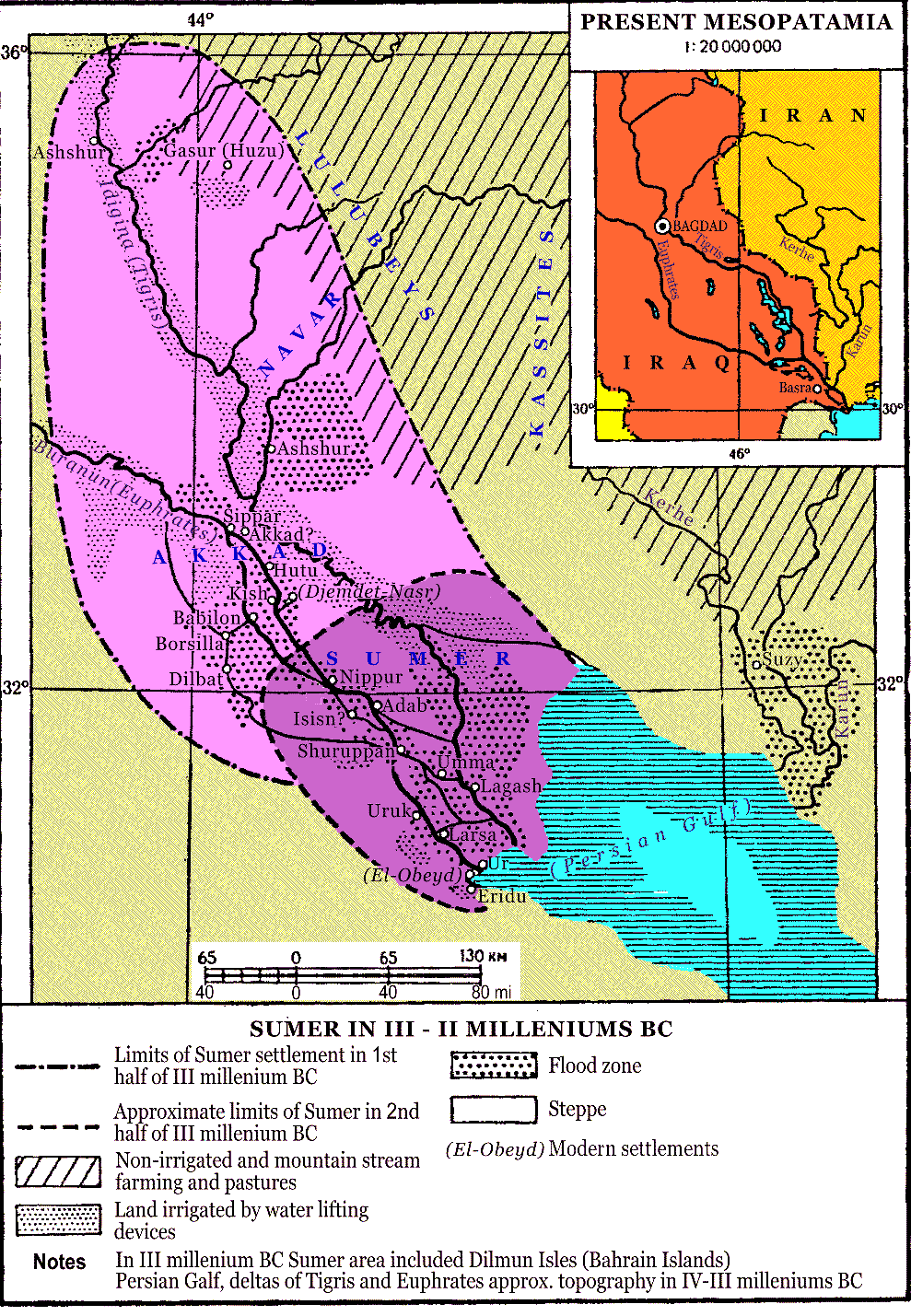
N. Mesopotamian Türkic areal in the 20th-23rd cc. BC
by Firidun Agasyoglu
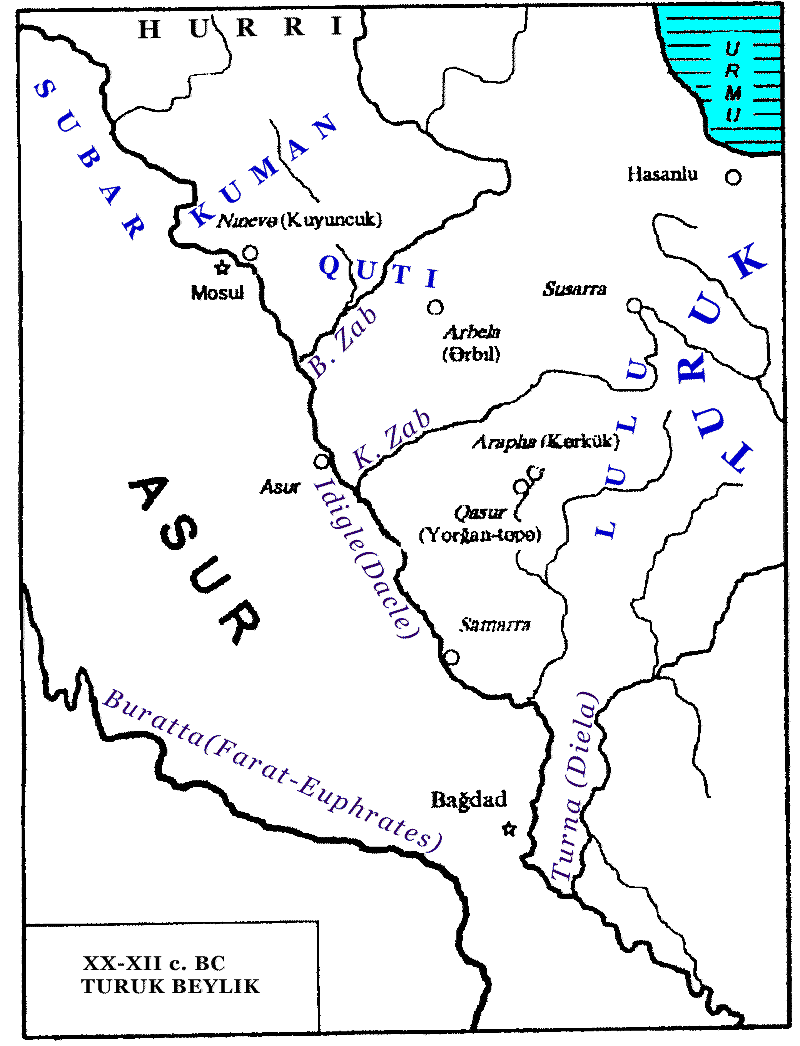
N. Mesopotamian Subar area in the 9th-8th cc. BC
by Firidun Agasyoglu
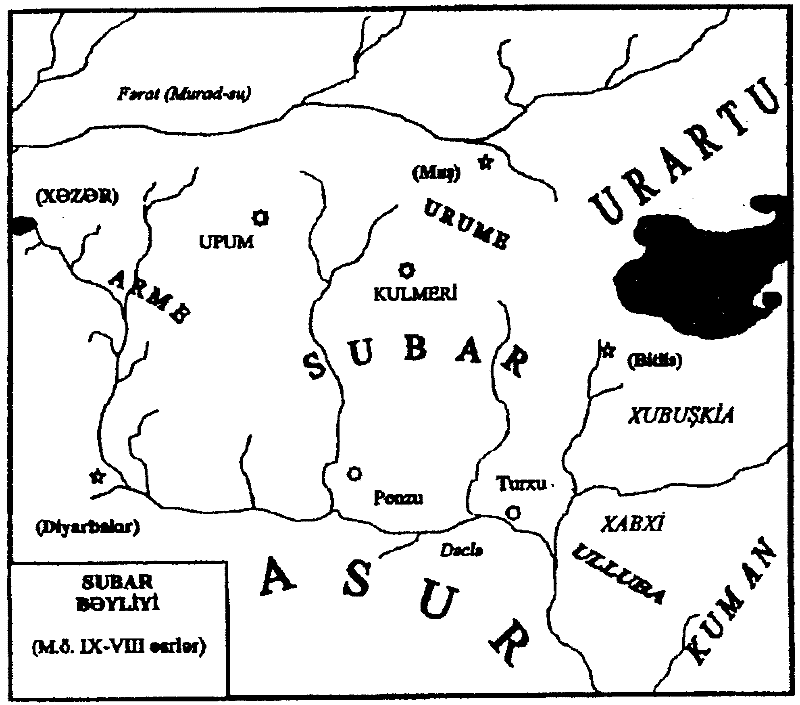
The presence of the ancient Türkic areal in the Near East is proved in addition that there, and also in the Asia Minor and Central Asia, some geographical objects still long before our era carried Türkic nominal names, some of which later became proper names.
So, The ancient Greek travelers and historiographers of the Alexander the Great, describing their way, recorded the local names for the geographical objects of the Asia Minor, Middle East and Central Asia.
For example, in the territory of the Asia Minor are mountains called Taurus (Pontic Taurus, Asia Minor Taurus) mountains. According to the ancient Greeks, the local peoples long before our era called by the word Taur these Taurus mountains and all the range of the mountains stretching from there to the east through the Middle East and Central Asia, down to the Himalayas [Piyankov I.V., 1997, 283]. Taur is by its origin the Türkic ethnonym with the meaning "Mountain People, Mountaineer". It is formed from the words tau/taw/tav "mountain" and ar/er "people, men". (A synonymous term for the “Mountaineer” is “qayači = qayachi”, with an element “Kai”, the term documented in the Uigur Tarim area)
The local Türks, acquainting the ancient Greek visitors with their area, called Taur (Taur Taulary "Mountains where live Taurs") any mountains where lived Taurs "Mountaineers". From that, the ancient Greeks recorded the Taur mountains, starting from Asia Minor and down to the Himalayas. This nominal name Taur, designating all mountains where lived Taurs "Mountaineers", later became a proper name for the mountains in the Asia Minor (and in the Crimea).
About the same may be said about the Türkic words Kaukas and Kroukas [Piyankov I.V., 1997, 283]. The local Türks of the Middle East and Central Asia named for the ancient Greeks all snow-white rocky mountains Kaukas "White Rocky Mountains" or Kroukas "Snowed Rocky Mountains". In the word Kaukas (Caucasus) kyu/kau "white", kas "rock" from the word of kas/kis "to cut", later in Türkic language it was replaced with a word kyya/kaya also from a word kyi/kay "to cut". In the second word kroukas the first part is krou "frost, snow", the second part is kas "rock".
The aboriginals of the Asia Minor and Central Asia represented some mountains to the Greeks under a name Oksiy. That, apparently, were the mountains from which were flowing clear rivers. Oksiy is from the Türkic oksay/oksuy/oksiy: ak/ok "white, pure", su/say/siy "river".
The same aboriginals called different rivers with the words Araks, Oks, Tanais which were nominal words: Araks comes from the Türkic aryk/arak "River, Canal"; Oks C from the Türkic aksu/oksu "White, Pure River"; Tanais comes from the Türkic tynys/tynych "quiet, calm", etc. [Piyankov I.V., 1997, 283-284].
Consequently, the axiom in the official historical science about an absence in the Near East and Asia Minor of the ancient Türkic area, about the arrival there of the first Türks only in the 11th century AD does not match the reality.
The evidence of the presence of the ancient Türkic-speaking area in the the Near East and Asia Minor remove the question what Türkic language affected the Sumerian. The fact is that in the records of the Akkadian sources the region to the south of Bagdad was called Kienkir (Kangar), there lived Sumerians, and the region to the north of Bagdad carried the name Subartu, there lived Subars. Sumerians did not call themselves Sumerians, their endoethnonym was Kangarli or Kangar. In Herodotus this ethnonym is found as angareon (see sect. 46 of this book). Akkadians and other peoples called Kangars "Sumerians" or "Shumerians", and this ethnonym they borrowed from the Subars, i.e. both Kangars (Sumerians), and Subars they called by the ethnonym Subar [Firidun Agasyoglu, 2000, 157], which in various language and dialect environments was pronounced differently: Sumar/Sumer/Shumer/Samar/Suar/Sabir/Savir/Sibir, etc.
Thus, language of Sumerians was influenced by the Subarian language and its dialects, or their nearest Türkic neighbors called then by the ethnonyms of Kuman, Kumyk, Turuk, Kuti, Lulu, Kashgay, etc., but the Sumerian language itself, in the believes of the many, was not Türkic.
It is possible to reason also in another way. A suggestion that Kangar, the endoethnonym of Sumerians, comes from the name of their territory, generates one more question: why this region was called Kangar? In fact, the Kangar is also an ethnonym, and specifically a Türkic one. Hence, here lived the Kangars, but when? Before the arrival here of Sumerians, were the Sumerians initially Türkic-speaking Kangars? If that is so, then already in the 4th millennium BC they experienced a period of assimilation among the Semitic-speaking Akkadians. In that case the Türkizms in the Sumerian language are not Türkic loans, but a Türkic substratum, i.e. the traces of the surmounted Türkic language, whose carriers later accepted the Akkadian language. A certain part of the Sumerians - Kangars, apparently, migrated to the Central Asia, where they merged with the Khwarezmians, in addition passing on to them the ethnonym Kangar, which became the reason for naming the Horasm(s) (Engl. "Khwarezmians" - Translator's Note) by the ethnonym Kangha/Kangüy/Kangar.
The ancient Türkic-speaking area in the Near East had a very strong Türkic influence on the Central Asia, Caucasus, Ural-Itil region, Western Siberia, and Kazakhstan....
90
30. ...
And what tribes (in the Central Asia) in the 3rd millennium BC could be Türkic-speaking? From the history we know that parallel with Sumer, in the Middle East and Central Asia was the state Elam. From the Sumerians, the Elamites adopted cuneiform writing, which from the middle of the 3rd millennium BC superseded the local hieroglyphs. Unfortunately, the Elam cuneiform writing has not been deciphered yet, therefore their language is unknown to us. The scientists established that it is not Indo-Iranian, and not inflectional, but agglutinating. Apparently, of all the agglutinating languages, in that region could only be the Türkic. Probably, the Elamite state in the Central Asia was created by Türkic-speaking tribes, and they named the country Elem, which in Türkic is "My Country" (Il-em > El-em > Elam). In addition, the scientists in the 19th and 20th centuries connected the Elamite language with the Türkic, but these attempts were outright rejected by the Indo-Iranians. I.M.Diyakonov without any reasons pronounced the Elamo-Türkic studies as being "under-scientific" [Diyakonov I.M., 1967, 107].
The culture of the Elamite state is traced in the history prior to the beginning of the1st millennium BC, then there, in the beginning of the 1st millennium BC, appear the Sakian [Validi A.-Z., 1981, 33-36] and Huarasmian [Dovatur A.I., Kallistov D.P., Shishova I.A., 1982, 119] states. In the following chapter we will specially shall note the Türkic-speaking of the Saks, simultaneously rejecting the concept about their Iranian-linguality.
Now we shall shortly stop on ethnogenetical conundrums of Khwarezmians (see the map of Central Asia in 3rd millennium BC). In an official historical science it is recognized that Khwarezmians from the very beginning were Iranian-lingual, only in the 6th-7th centuries, under the influence of the nomad Türks they switched from the Iranian language to Türkic. As it was already said above, this viewpoint does not bear criticism. Actually, the Khwarezmians from the very beginning were Türkic-speaking, and in that condition joined the body of the modern Türkic-speaking peoples of the Central Asia and Kazakhstan. These are the opening remarks.
Central Asia in the 3rd millennia BC
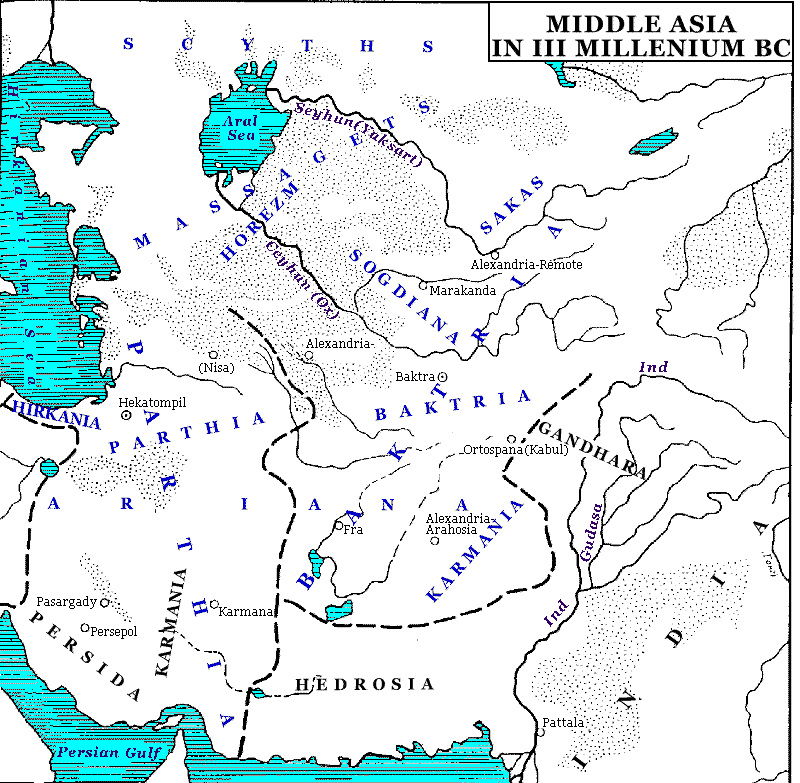
The second observation pertains to the etymology of the ethnonym Horezm, which in antiquity had forms Hvarizm, Horasm, Horamni. Dissecting this ethnonym into semantical components following the Türkic model of ethnonyms, in the variations Hvarizm, Horasm, Horezm we shall see two roots, Huar and As, and a personal case singular affix of belonging -ì (-ûì). Huar is in another way Suar, which consist of two roots su (hu > khu) "water" and ar, the most ancient Türkic ethnonym meaning "people, men": Huar as a whole is "River People". The presence of the ethnonym Suar in the ethnonym Huarasm indicates that Huarases to some extent are the descendants of the Subars (Suars) of the Near East. Besides, the ethnonym Suar (Huar) was actively used in the Caucasus, in the Ural-Itil region, and apparently, also in the Central Asia. The second part of the ethnonym Huarasm is As, it is also the most ancient Türkic ethnonym. The Huaras means Ases, but from a tribe of Suars. The Huarases created their state, and it, and the country were called not simply the Huaras, but with a love were called Huarasm "My Huaras". Eventually, the name Huarasm of the country began also be applied with a meaning of the ethnonym Huarasm > Horezm.
That the first part of the ethnonym Huaras consist of the Türkic ethnonym Suar (Huar) tells the variation Horamni, with no ethnonym As, but is an affix of belonging -ì (ni-, apparently, a later formation under the influence of the Iranian).
In the single root (suar/huar) in the two ethnonyms, Sumer (Sumer/Sumar/Subar) and Horezm (¾uar-as-m) we see visible traces of the ethnic kinship of the Sumerians and Khwarezmians. Besides, we also observe that Sumerians had their endoethnonym as Kangar, and the Khwarezmians were called by the other peoples Kangha or Kangüy [Tolstov S.P., 1948, 341]. One primary ethnonymic root kang/kang "primogenitor" is the base of all these three ethnonyms.
Next to Suars and Ases (Huarases) in the valley of Pamir and Hindukush (which is Hindu Kush, i.e. Hindu Rockies in Türkic - Translator's Note) lived Bulgars, whose ethnonym (like the ethnonym Suar) means "River People". Bulgars and Suars lived close by also in the Itil region. The Bulgarian scientists state the opinion that the Bulgars are the migrants from the Central Asian Türkic areal. The Bulgars then participated in the creation the Türkic-speaking areal in the N. Pontic around Danube.
The science established that the tribes carrying initial (simple) ethnonyms lived much before those that carried the secondary (composite) ethnonyms. Therefore it should be recognized that in the Central Asia also, much before the Huarases, lived Ars,Ases, Suars.
Once again I turn the attention the readers that still in antiquity the Türks called their country yours with respect and love, adding a pronoun mine, which in Türkic is transmitted with the affix of belonging in personal singular case: Huarasm, Elem > Elam, Kyrym, Biarm, etc.
With the Horasmians (Khwarezmians) were closely connected to Pards (Parthians) (Because of the absence in the contemporary Russian the interdental "th", the author here substitutes "d" for it - Translator's Note). Being in a subordinated position to Persians, in the army of the Persian king Kserks, the Parthes, Horasmis, Sogds, Gandaris and Dadiks together composed one group, the Parthes and Horasmis were under command of a single leader [ Herodotus 7, 66].
Here first of all should be noted that the Parthes (Parthians) originally were Türks and a part of the Türks of the Central Asia. If they were Iranian-lingual, under the influence of the nomadic Türks they could not acquire the Türkic language, but on the contrary, they necessarily would assimilate the "newcoming" of the "nomadic" Türks, transferring the Indo-Iranian language to them.
The ethnonym Parthy also is etymologized by the Türkic model. Parthy consist of a word par (bar) "have, plentyness, riches" and an affix -dy ( -ly), Parthy means "rich, having wealth, well off". In the Russian the sound th was transmitted by theta [Θ] and later by f, therefore from Parthy came the Russian variation Parfy > Parfiane. That the Parthy is an ethnonym of a Türkic origin also tells that we meet it in the r. Kama basin as Bardy and as a name of a location with an affix of belonging -ì: Bardym. In the Azerbaijan up to the Mongolian conquest was a blossoming trading and craft center Barda, which name comes from the ethnonym of its inhabitants.
The state of the Parthy people was created in the 3rd century BC in the south and southeast of the Caspian Sea during the struggle against the Greeks and Iranians. During its height it subordinated extensive areas from Mesopotamia to the borders of India. Apparently, even in the Sumerian time the Parthys reached the Near East and interacted with the Sumerians (see the map of the Parthys' empire). Later, the Parthes were instrumental in the formation the Turkmen people. The former Parthys began to be called Turkmens. Apparently, the Hamsin Turkmens in the east of the Persian gulf, the Iraqi and Syrian Turkmens remained living there since those times when the Parthys state controlled a huge territory in the Middle East and Central Asia.
Parthian Kingdom 250 BC to 220 AD
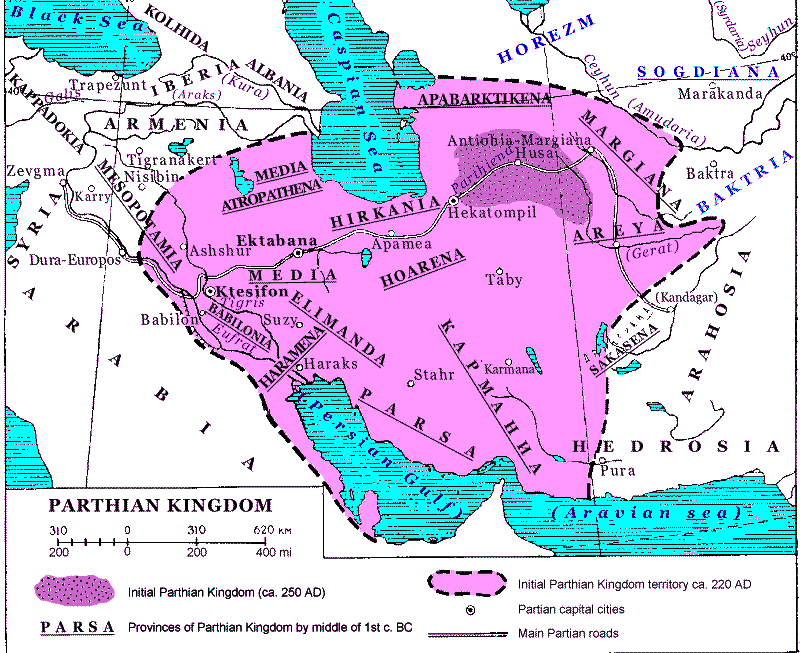
99
31. ...
...The presence of the ancient Türkic area in the Ural-Itil region is indirectly proved by the fact of the establishment of the close ethnic, economic and political connections of that region with the Middle East and Central Asia.
Let's start with that the Near East, Central Asia and the Ural-Itil region are linked by their ancient common tribes of Subars and Kangars. As was already stated, the endoethnonym of the Sumers/Shumerians was Kangar/Kungur, because they spoke one language with the Subars, the Akkadians also these Kangars called with the ethnonym Subar/Sumar/Sumer/Shumer. The ethnonym Subar/Huar is also a part of the name Huarases/Horasmis/Horezmians. They were also called with the ethnonym Kangar/Kang/Kangha. The names of these tribes are also recorded in the Ural-Itil region. Here their traces are preserved in the toponyms Kungur, Suar. It is possible to also add here the presence of the ancient toponyms Osa, Asly/Ashly, which are linked with the tribes carrying ethnonym As. We should recall that in addition to Suar, in the composite ethnonym Huarasm/Huaras, also is the ethnonym As (Huar-As).
The Suars and Kangars have left their trace in the Near East in the 4th-3rd millenniums BC, in the Central Asia in the 2nd-1st millenniums BC. And since what time the Suars and Kangars could live in the Ural-Itil region? Taking into account that this region is considered to be an ancestral home of the Türks, apparently, they have appeared there earlier than in the Middle East and Central Asia.
The ethnonym Subar had also phonetic variations as Sumer/Samar, which were recorded in the toponyms in the Central Asia (Samar-kend), and in the Itil region (Samara, Sumer)....
Horezmian Vessels
First of all it should be noted that the name Sibir itself (Engl. Siberia - Translator's Note) historically ascends to the Türkic ethnonym Subar/Suar/Sabir/Sibir. And the most ancient carriers of this ethnonym in the 4th-3rd millenniums BC lived in the Middle East, and formed of them and the Ases Huarasy lived in the Central Asia in the 2nd millennium BC. For the Subars/Sabirs and Horasmis the access to the coast of the Caspian Sea was a usual event, and then by the rivers Yaik - Miass-Tobol-Irtysh-Ob they were reaching the Arctic Ocean, where the Kara Sea received the (Türkic - Translator's Note) name Kar dinggeze "Snow Sea".
Let's recollect the ethnonym Kangar, which was the endoethnonym of the Sumerians and a part of the Horasmis. Together with the Horasmians there were also Ases (Huar+As). The carriers of these ethnonyms, i.e. Kangars and Ases, have also reached the Western Siberia, and in the 7th century BC on the banks of the r. Yenisei they created a powerful state association called Kangaras, and it prospered up to the 5th century AD. Its possessions reached the Central Asia. The Kangaras state was ruled during various times from the different centers: Kesh, Kusan, Tashkent, Bukhara, even Samarkand. The Kangaras state included all Western Siberia. In the opinion the scientists, it left a rich Tagar archeological culture. It is also considered to be a significant part of the Scythian confederation of peoples (but the discourse about Scythians is coming below).
105
Origin of Türks-Contents · Introduction · First chapter · Second chapter · Third chapter · Fourth chapter · Fifth chapter · ORIGIN OF TATARS
Back
In Russian
Contents Sumers
Contents Amerindian
Roots
Writing
Language
Religion
Geography
Archeology
Coins
Wikipedia
Türkic, Slavic and Iranian
Türkic in Romance
Alans in Pyrenees
Türkic in Greek
Türkic in Slavic
Türkic languages
Classification of Türkic languages
Indo-European, Dravidian, and Rigveda
Türkic and European Genetic distance
Türkic-Sumerian
Avar Dateline
Besenyo Dateline
Bulgar Dateline
Huns Dateline
Karluk Dateline
Kimak Dateline
Kipchak Dateline
Kyrgyz Dateline
Sabir Dateline
Seyanto Dateline